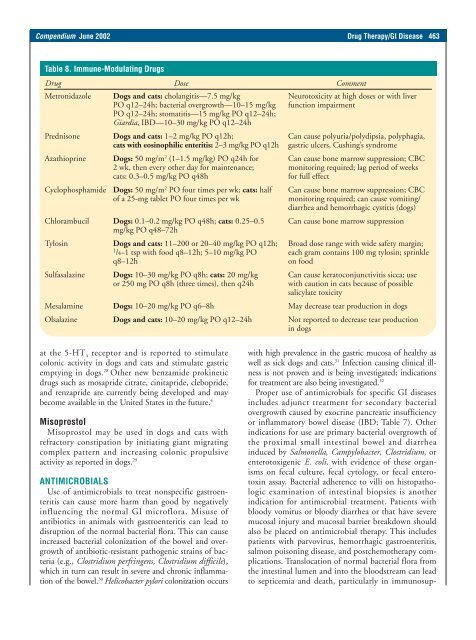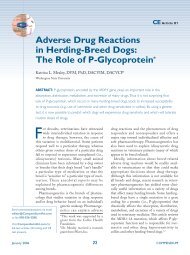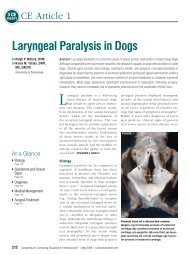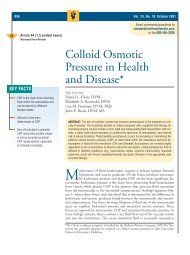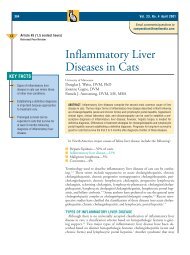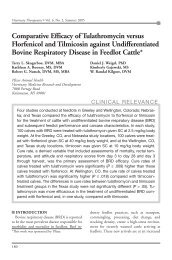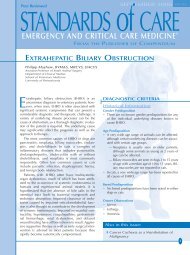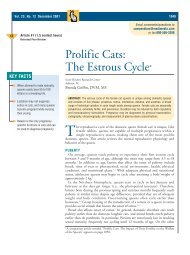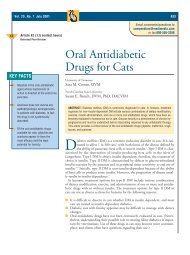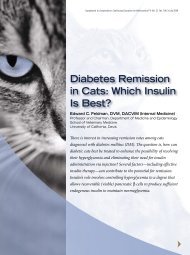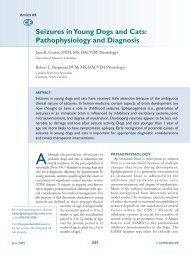Create successful ePaper yourself
Turn your PDF publications into a flip-book with our unique Google optimized e-Paper software.
Compendium June 2002 Drug Therapy/GI Disease 463<br />
Table 8. Immune-Modulating Drugs<br />
Drug Dose Comment<br />
Metronidazole Dogs and cats: cholangitis—7.5 mg/kg Neurotoxicity at high doses or with liver<br />
PO q12–24h; bacterial overgrowth—10–15 mg/kg<br />
PO q12–24h; stomatitis—15 mg/kg PO q12–24h;<br />
Giardia, IBD—10–30 mg/kg PO q12–24h<br />
function impairment<br />
Prednisone Dogs and cats: 1–2 mg/kg PO q12h; Can cause polyuria/polydipsia, polyphagia,<br />
cats with eosinophilic enteritis: 2–3 mg/kg PO q12h gastric ul<strong>ce</strong>rs, Cushing’s syndrome<br />
Azathioprine Dogs: 50 mg/m2 (1–1.5 mg/kg) PO q24h for Can cause bone marrow suppression; CBC<br />
2 wk, then every other day for maintenan<strong>ce</strong>; monitoring required; lag period of weeks<br />
cats: 0.3–0.5 mg/kg PO q48h for full effect<br />
Cyclophosphamide Dogs: 50 mg/m2 PO four times per wk; cats: half Can cause bone marrow suppression; CBC<br />
of a 25-mg tablet PO four times per wk monitoring required; can cause vomiting/<br />
diarrhea and hemorrhagic cystitis (dogs)<br />
Chlorambucil Dogs: 0.1–0.2 mg/kg PO q48h; cats: 0.25–0.5<br />
mg/kg PO q48–72h<br />
Can cause bone marrow suppression<br />
Tylosin Dogs and cats: 11–200 or 20–40 mg/kg PO q12h; Broad dose range with wide safety margin;<br />
1 /4–1 tsp with food q8–12h; 5–10 mg/kg PO each gram contains 100 mg tylosin; sprinkle<br />
q8–12h on food<br />
Sulfasalazine Dogs: 10–30 mg/kg PO q8h; cats: 20 mg/kg Can cause keratoconjunctivitis sicca; use<br />
or 250 mg PO q8h (three times), then q24h with caution in cats because of possible<br />
salicylate toxicity<br />
Mesalamine Dogs: 10–20 mg/kg PO q6–8h May decrease tear production in dogs<br />
Olsalazine Dogs and cats: 10–20 mg/kg PO q12–24h Not reported to decrease tear production<br />
in dogs<br />
at the 5-HT 4 re<strong>ce</strong>ptor and is reported to stimulate<br />
colonic activity in dogs and cats and stimulate gastric<br />
emptying in dogs. 28 Other new benzamide prokinetic<br />
drugs such as mosapride citrate, cinitapride, clebopride,<br />
and renzapride are currently being developed and may<br />
be<strong>com</strong>e available in the United States in the future. 4<br />
Misoprostol<br />
Misoprostol may be used in dogs and cats with<br />
refractory constipation by initiating giant migrating<br />
<strong>com</strong>plex pattern and increasing colonic propulsive<br />
activity as reported in dogs. 29<br />
ANTIMICROBIALS<br />
Use of antimicrobials to treat nonspecific gastroenteritis<br />
can cause more harm than good by negatively<br />
influencing the normal GI microflora. Misuse of<br />
antibiotics in animals with gastroenteritis can lead to<br />
disruption of the normal bacterial flora. This can cause<br />
increased bacterial colonization of the bowel and overgrowth<br />
of antibiotic-resistant pathogenic strains of bacteria<br />
(e.g., Clostridium perfringens, Clostridium difficile),<br />
which in turn can result in severe and chronic inflammation<br />
of the bowel. 30 Helicobacter pylori colonization occurs<br />
with high prevalen<strong>ce</strong> in the gastric mucosa of healthy as<br />
well as sick dogs and cats. 31 Infection causing clinical illness<br />
is not proven and is being investigated; indications<br />
for treatment are also being investigated. 32<br />
Proper use of antimicrobials for specific GI diseases<br />
includes adjunct treatment for secondary bacterial<br />
overgrowth caused by exocrine pancreatic insufficiency<br />
or inflammatory bowel disease (IBD; Table 7). Other<br />
indications for use are primary bacterial overgrowth of<br />
the proximal small in<strong>test</strong>inal bowel and diarrhea<br />
indu<strong>ce</strong>d by Salmonella, Campylobacter, Clostridium, or<br />
enterotoxigenic E. coli, with eviden<strong>ce</strong> of these organisms<br />
on fecal culture, fecal cytology, or fecal enterotoxin<br />
assay. Bacterial adheren<strong>ce</strong> to villi on histopathologic<br />
examination of in<strong>test</strong>inal biopsies is another<br />
indication for antimicrobial treatment. Patients with<br />
bloody vomitus or bloody diarrhea or that have severe<br />
mucosal injury and mucosal barrier breakdown should<br />
also be pla<strong>ce</strong>d on antimicrobial therapy. This includes<br />
patients with parvovirus, hemorrhagic gastroenteritis,<br />
salmon poisoning disease, and postchemotherapy <strong>com</strong>plications.<br />
Translocation of normal bacterial flora from<br />
the in<strong>test</strong>inal lumen and into the bloodstream can lead<br />
to septi<strong>ce</strong>mia and death, particularly in immunosup-


